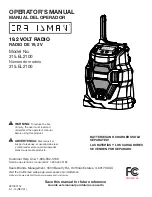
8
• H/L - (#7 key) used to select/enable radio external
alarms.
• Mon - (#8 key) used to monitor for channel traffic.
• Dir - (#9 key) used for talkaround (mobile-to-
mobile) conversations.
• Rcl - (* key) used to review modes in scan and
phone lists.
• Del - (# key) used when editing stored lists.
B. Theory
Overview
The pushbutton ON/OFF switch (S1) or rotary
switch (on rotary control heads) applies battery power to
the control head, transceiver, and accessory connector
via the SW B+ line. Jumpers JU1 and JU2 on the control
head board are used to enable the IGNITION feature.
JU1 is normally out and JU2 is normally in. This allows
complete control over Transmit/Receive functions
shown in Table 1.
Switched B+ is applied to a voltage regulator (U45),
which supplies regulated 5 Vdc to the microcomputer
(U1) circuitry, the interface circuits, the vacuum fluores-
cent (VF) driver (U101), and to the comparator (U3).
The microcomputer (U1) communicates with the
radio command board via the serial bus, scans the con-
trol head keyboard for activity, and generates the
display information for the VF driver (U101) and VF dis-
play (U102). U1 uses a 4 MHz ceramic resonator (Y1)
for its clock source.
When switched B+ is initially applied, the RESET
line to pin U1-1 is held low for approximately 120 mil-
liseconds before it goes high. The high resets U1 and
starts it operating properly. A resultant signal at pin U1-
38 provides a 1kHz tickle pulse to the watchdog timer
circuit in the serial input/output IC (U4), and provides a
strobe signal to the VF display driver (U101). If the tick-
le pulse disappears for more than 120 milliseconds, the
reset sequence is initiated and pin U4-9 goes high.
Table 2 illustrates the serial data bus logic states.
The VF display is an eight-character, fourteen-seg-
ment, alphanumeric device. The anodes and the grids
operate at approximately 34 Vdc when ON and 0 Vdc
when OFF. The filament operates at approximately 2.4
Vac rms.
The voltage for the VF Display is generated by a
fixed-frequency, variable duty-cycle, controlled-flyback
voltage converter. The switching frequency is approxi-
mately 210 kHz.
Microcomputer line U1-6 controls the voltage
converter, which provides approximately 37 Vdc to the
VF driver (U101-1) and approximately 2.4 Vac rms
across T60-4 and T60-6 to the VF display (U102-1 and
U102-25).
IV. TRANSCEIVER
A. Receiver Front End
The receiver front end consists of a preselector, a
mixer circuit, and an injection filter.
The mixer is designed for low-side injection. The
receiver injection (first local oscillator) comes from the
doubler output of the VCO assembly (825-831 MHz) via
a coax cable. The injection filter is a printed pattern on
the mixer hybrid substrate and is laser-tuned at the fac-
tory. The output of the filter is connected to the mixer
device.
The preselector is a fixed-tuned ceramic-block filter
that is soldered to the mounting bracket underneath the
mixer hybrid. The receive signal (935-941 MHz) is fed
to the preselector from the antenna switch in the PA.
The signal is then sent up to the mixer hybrid where it is
connected to the mixer transistor (Q9126). The receive
injection is also fed to this point. The mixer output is at
the first IF center frequency of 109.65 MHz. Typical
conversion gain for the entire front-end assembly is 7.5
dB. This signal is sent to the first IF on the RF board via
a coaxial cable.
Customer Options
JU1
JU2
Comments
1. RX & TX enabled
OUT
OUT
Connect ignition cable*
via on/off switch on
to “Battery Plus (+)”
control head
terminal.
2. RX & TX enabled
OUT
IN
Connect ignition cable*
via ignition switch
to “Ignition Switch.”
3. RX enabled via on/off
IN
OUT
Connect ignition cable*
off switch on control
to “Ignition Switch.”
head; TX enabled
via ignition switch
Table 1. Control Head Jumper Table**
* Ignition cable is a part of the cabling which plugs into the rear
accessory connector (P2) on the back of the radio. The ignition
cable must be connected to Pin P2-5 for Table 1 to be valid.
** Refer to Detailed Service Manual board overlays for jumper
location.
No
Bus Activity
Data Line
Bus Activity
(Sending or
In
(Normal)
Receiving Data)
Reset*
Busy
Low
High
Low
Busy in
High
Low
High
Busy out
High
Low**
High
Bus +
High
Low and High
High
Bus —
Low
High and Low
Low
TX DATA
High
Low and High**
High
RX DATA
High
Low and High
High
RESET
Low
Low
High
RESET
High
High
Low
Table 2. Serial Data Bus Logic States
* Data will be sent (bus activity) immediately after a reset.
** Sending only.
Summary of Contents for Spectra
Page 6: ...v PERFORMANCE SPECIFICATIONS FOR SPECTRA PRIVACY PLUS TRUNKED CONVENTIONAL 900 MHz RADIO ...
Page 7: ...vi PERFORMANCE SPECIFICATIONS FOR SPECTRA SMARTNET TRUNKED CONVENTIONAL 900 MHz RADIO ...
Page 8: ...vii PERFORMANCE SPECIFICATIONS FOR SPECTRA 9000 RADIOS 900 MHz 30 WATTS ...
Page 25: ...1 GENERAL INFORMATION 1 ...
Page 73: ...53 INSERT GPW 7221 B Figure 22 Front Panel Diagnostics Key Closure Displays ...
Page 75: ...INSERT GXW 4278 O PICKUP FROM PW 4320 O 55 CONTROL STATION WIRING DIAGRAM ...
Page 79: ...PUSHBUTTON SPECTRA 900 MHz RADIO MECHANICAL EXPLODED VIEW 59 INSERT GXW 6225 B ...
Page 96: ...82 MECHANICAL EXPLODED VIEW PARTS LIST FOR SPECTRA 900 MHz RADIO ...
















































